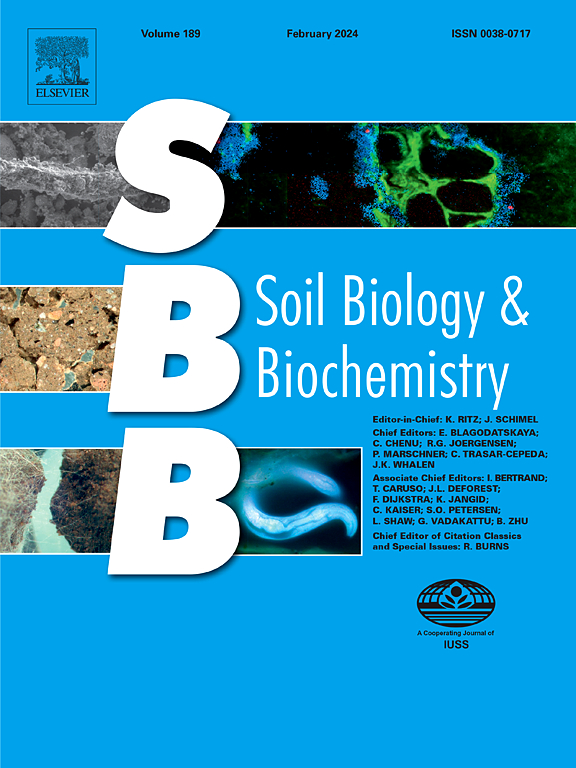Litter decomposition and prokaryotic decomposer communities along estuarine gradients
IF 9.8
1区 农林科学
Q1 SOIL SCIENCE
引用次数: 0
Abstract
Climate change-driven sea-level rise and saltwater intrusion will impact carbon cycling in estuarine marshes by altering litter decomposition. We examined how litter quality and environmental conditions affect litter decomposition and prokaryotic communities along salinity and flooding gradients of the Elbe Estuary. Native and standardized litter (Tea Bag Index) were incubated in soils of various marsh types (freshwater, brackish, salt) and flooding frequencies (daily, monthly, yearly). Prokaryotic communities colonizing litter and soil were identified using 16S rRNA gene amplicon sequencing. Our results showed that litter quality is a key factor for litter decomposition in the estuary. Native litter decomposition increased with increasing salinity and decreasing flooding frequency. This was driven by litter chemistry, with higher lignin content and lignin:N ratio in the freshwater compared to the salt marsh vegetation and in pioneer zone compared to higher marsh vegetation. In contrast, tea litter decomposition declined with rising salinity, indicating adverse environmental conditions for decomposition with increasing salinity. Flooding effects varied with litter quality: mass loss of recalcitrant litter (rooibos tea) decreased with higher flooding frequencies, while mass loss of labile litter (green tea) increased. Prokaryotic communities in native and tea litter displayed distinct assemblages and lower diversity than the local soil community, indicating selective colonization of litter, which was particularly pronounced for tea litter. Tea mass loss benefited from a diverse soil prokaryotic community, while native litter mass loss was driven by an adapted local soil prokaryotic community. Our findings highlight biotic (litter quality, prokaryotic community) and abiotic (salinity, flooding) controls on litter decomposition in estuarine environments, suggesting that projected changes in salinity and hydrodynamics due to climate change could alter decomposition dynamics in these environments.
河口梯度凋落物分解和原核分解者群落
气候变化导致的海平面上升和盐水入侵将通过改变垃圾分解来影响河口沼泽的碳循环。我们研究了易北河口盐度和洪水梯度上的垃圾质量和环境条件如何影响垃圾分解和原核生物群落。在不同沼泽类型(淡水、咸水、盐水)和不同淹水频率(每天、每月、每年)的土壤中培养原生垃圾和标准化垃圾(茶包指数)。利用 16S rRNA 基因扩增片段测序鉴定了定植于垃圾和土壤中的原核生物群落。我们的研究结果表明,垃圾质量是河口垃圾分解的关键因素。随着盐度的增加和洪水频率的降低,原生枯落物的分解量也在增加。木质素含量和木质素与氮的比例在淡水植被中比在盐沼植被中高,而在先驱区则比在高等沼泽植被中高。相比之下,茶叶枯落物的分解率随着盐度的升高而下降,这表明随着盐度的升高,环境条件不利于枯落物的分解。洪水对枯落物质量的影响各不相同:随着洪水频率的增加,难降解枯落物(罗布麻茶)的质量损失减少,而易腐烂枯落物(绿茶)的质量损失增加。与当地土壤群落相比,原生落叶和茶叶落叶中的原核生物群落显示出不同的组合和较低的多样性,这表明落叶的选择性定殖,在茶叶落叶中尤为明显。茶叶的质量损失得益于多样化的土壤原核生物群落,而本地枯落物的质量损失则是由适应当地土壤的原核生物群落造成的。我们的研究结果强调了河口环境中生物(垃圾质量、原核生物群落)和非生物(盐度、洪水)对垃圾分解的控制,表明气候变化导致的盐度和水动力的预期变化可能会改变这些环境中的分解动力学。
本文章由计算机程序翻译,如有差异,请以英文原文为准。
求助全文
约1分钟内获得全文
求助全文
来源期刊

Soil Biology & Biochemistry
农林科学-土壤科学
CiteScore
16.90
自引率
9.30%
发文量
312
审稿时长
49 days
期刊介绍:
Soil Biology & Biochemistry publishes original research articles of international significance focusing on biological processes in soil and their applications to soil and environmental quality. Major topics include the ecology and biochemical processes of soil organisms, their effects on the environment, and interactions with plants. The journal also welcomes state-of-the-art reviews and discussions on contemporary research in soil biology and biochemistry.
 求助内容:
求助内容: 应助结果提醒方式:
应助结果提醒方式:


